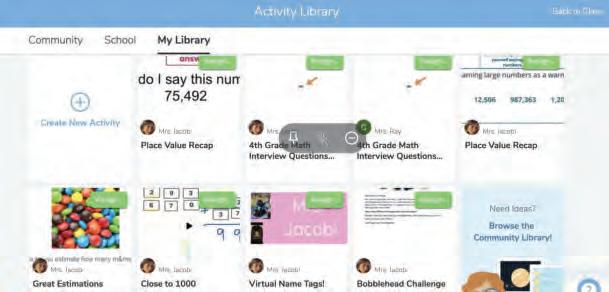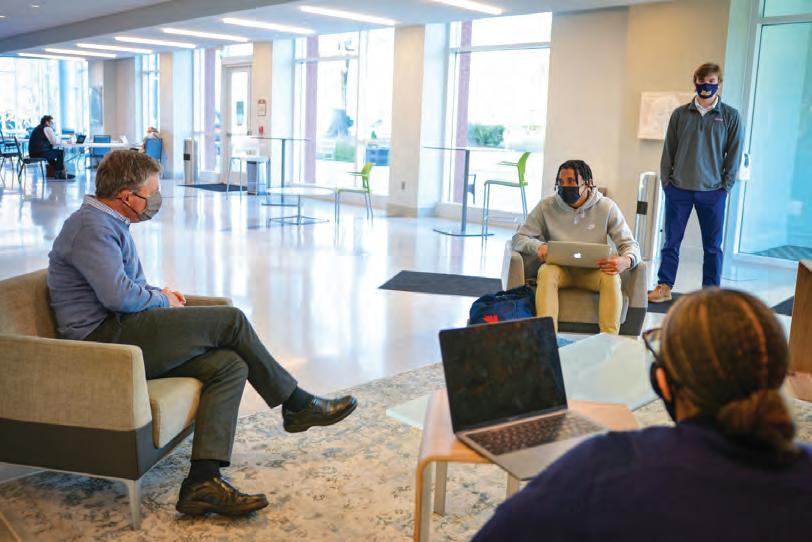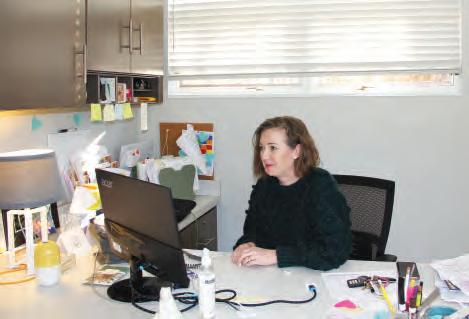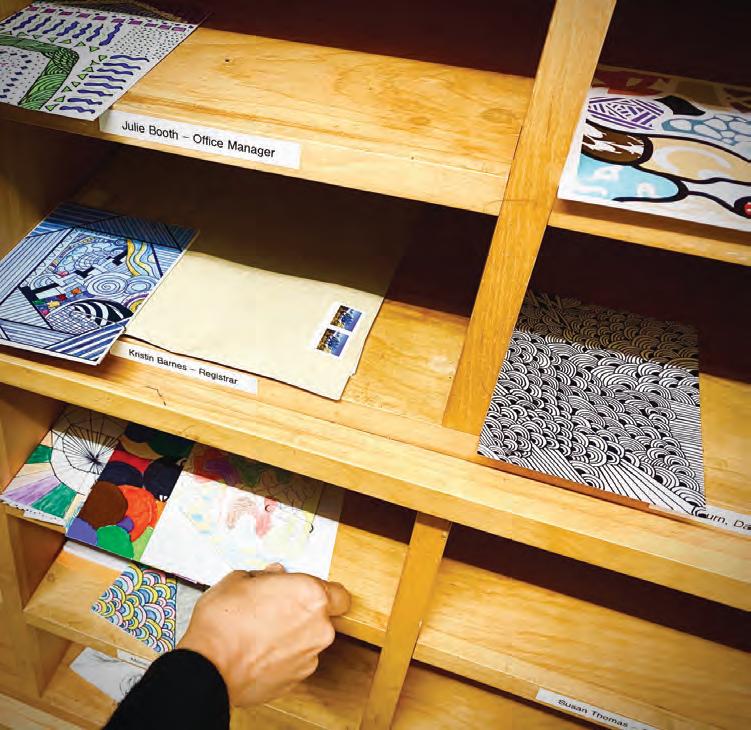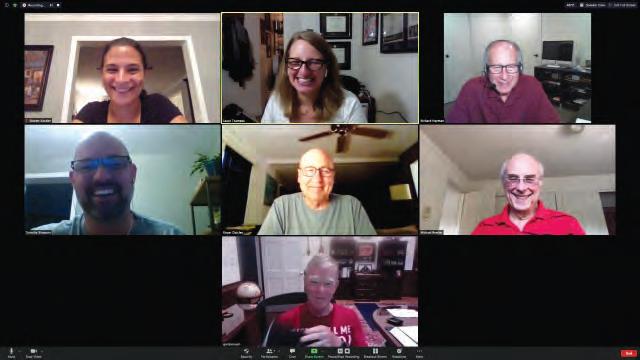
10 minute read
Academics
Thinking Inside and Outside the Box: Education in a Kit
Teachers often think outside the box when designing lessons for their students. This year, as normal educational methods met challenges, Bullis teachers found solutions—inside actual boxes.
Advertisement
When an educational quick-change became necessary at Bullis in March 2020, faculty created a comprehensive—and resoundingly successful—remote learning program. But hands-on classes needed especially creative solutions. Anthony Brooks, technical theatre director and teacher, wanted to be prepared come September—and had an idea to package materials for his Upper and Middle School students. “I looked for ways to teach remotely in technical theatre using safe and eff ective teaching tools and methods, no matter what form classes took.”
Over the summer, Brooks spent countless hours making lists and gathering materials to create nearly one hundred educational kits containing Styrofoam, paints, spackle, crayons, and more. He wanted to make it possible for remote and in-class Upper School students to make scenic and production designs and prop foods like cakes, sundaes, and burgers. He also fi lled kits for Middle School students with socks, cloth, accessories, and small plastic skeletons “perfect for teaching movement in puppeteering.”
Brainstorming the possibilities, Brooks and several Bullis colleagues rolled up their sleeves to assemble hundreds of kits for various subjects. Such ingenuity and eff ort is allowing classroom and remote students to complete projects in tech theatre, visual arts, BITlab, and even science classes. Neatly packaged and labeled, the kits are “very innovative,” said Brooks, who is documenting the process in his classes.
Supported by the Bullis Fund, the School made supplies and technology available as faculty devised creative educational solutions. “Bullis even provided advanced tech theatre students with a device to turn laptops into light boards,” Brooks said. “I couldn’t have done this at another school.”
In Upper School painting, Art Teacher Angela Swadling’s in-class students wear masks and keep their distance at large
Left: Lower School student retrieves box of art supplies from the hallway. Above: Lighting kits beside supplies for Advanced Design students.
tables divided by tall Plexiglas barriers. They completed a postcard art project using supplies provided in individual boxes stacked high on countertops and carts.
Along with Swadling, Art Teacher Alice Shih-Kahn and Director of Visual Arts Kathleen Adams collaborated on art kits containing pencils, pastels, charcoal, acrylic paints, and watercolors; sculpture and ceramics kits include clay, wire, cardboard, mini-glue guns, and carving tools. “A lot of brainpower and work went into putting all these boxes together!” Shih-Kahn said. Adams agrees. “We had to determine how to off er the full range of studio art classes while accommodating the hybrid learning model.”
Shih-Kahn’s Ceramics I students take clay and tools from sturdy plastic containers to make clay bowls. Guiding her classroom students, Shih-Kahn then uses a laptop and
camera setup to demonstrate a technique to a remote student. Decorated and fi red, the bowls will be donated to the Empty Bowls project, which provides handcrafted bowls fi lled with food for individuals in need.
The Bullis kits are as useful in the classroom as at home. Health protocols preclude the sharing of supplies, tools, keyboards, and so on. Items that are touched must be sanitized and set aside between uses. This holds true in the BITlab as well.
“Educators worldwide are looking for new ways to teach this year,” explains BITlab Coordinator Matt Zigler, who prepared dozens of kits for his Maker Lab classes. “All summer teachers shared ideas and methods on Twitter and maker education sites.” Bullis faculty expanded the concept of educational kits to accommodate the needs of their students. Zigler himself has been largely remote this year, working virtually with 9th through 12th grade students; BITlab classes are supervised by STEM Director Mark Walter, who helps out while Zigler appears onscreen.
Wanting to give students equal access to materials, Zigler carefully selected items including hot glue guns, cardboard, paper circuits, copper tape, LED bulbs, binder clips, and more. Kit components that create basic electrical circuitry can be used for other projects, encouraging fl exibility and creative thinking. Zigler’s kits are designed to be versatile; even the cardboard boxes can be used.
Usually, students make prototypes in maker class and digitize their designs, then work with the teacher to create the item using computer consoles and 3D printers. This year, students make and digitize prototypes, while Zigler goes into the BITlab to produce the three-dimensional pieces.
During a unique year, he fi nds one advantage to teaching remote students while remote himself. “We can see each other’s faces! Communicating while wearing masks in class is not easy.” In Dr. Badraslioglu’s popular Anatomy and Physiology classes, lab kits and athome materials proved “very eff ective and effi cient for our chicken feet dissection lab.” Some remote students picked up kits curbside; others bought the items. While Blue team students dissected in class, Gold team students completed research and discussions, then switched roles. Exploring the anatomical structure of chicken feet, inclass students took notes using keyboards covered in cling-wrap to maintain sanitized standards.
The students also dissected Gummy Bears to study anatomy; remote students needed only basic kitchen tools. “In science,” Dr. B. said, “there are so many materials that we can’t send home for kids to use on their own. But making a sagittal incision in a Gummy Bear in school or at home is a great way to learn anatomy.”
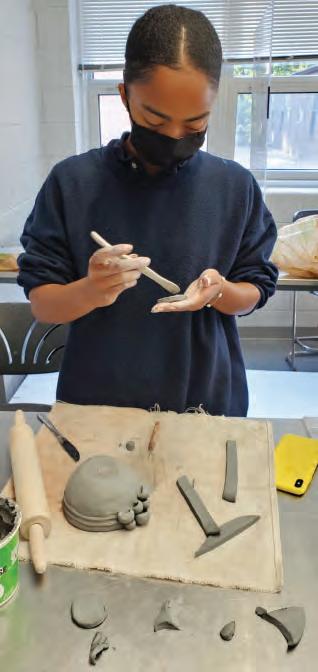
“Unique times call for innovative approaches,” Anthony Brooks says. “Teachers everywhere have had to switch gears this year.”
A worthwhile eff ort: on campus and at home, Bullis students enjoy continuity as well as safety.
Top: Upper School ceramics student in the studio. Below: Director of Visual Arts Kathleen Adams assembles studio art kits.

By Lisa Vardi, Director of Teaching and Learning


Unit 1 Final Assessment
You serve as advisors to a newly elected President of a state characterized by political scientists as an emerging democracy. Ten years prior, this state had experienced a regime change, moving from a military dictatorship to a democracy. The newly elected President, who will serve a single six-year term, is committed to strengthening democracy for all citizens.
Write a 500-word memo with recommendations on how to achieve the following goals:
Building of a strong, stable democracy
Ensuring a high degree of legitimacy

Measuring the above goals in valid and reliable ways (include three quantitative measurements)

Teaching in a hybrid learning model has brought enormous challenges to Bullis, but also opportunities to rethink how we measure student learning. Traditionally, the above assessment in Advanced Placement Comparative Government and Politics (APCGP), a 12th grade social studies elective, would have consisted of 25 multiple-choice questions and two short answer responses in a paper and pen format. With more than half of my students learning remotely on an given day this school year, the “traditional” test was not feasible. Instead, students worked in pairs on this performance task and had 24 hours to complete it.
What is a performance task? It is an assignment that asks students to apply or transfer their learning in some fashion, in this case, students were asked to create what curricular expert, Jay McTighe calls, “a multifaceted, structured response for an authentic audience.” Writing a memo for a president as your audience, even if fi ctitious, is more meaningful than writing an essay for a teacher! Performance tasks are just some of the ways Bullis teachers are rethinking how to measure student learning in a hybrid year of learning with some students learning remotely and some in the classroom.
In a humanities-based classroom such as English, social studies, or world languages, it may be easier to pivot to more performancebased assessments. Several years ago, the Bullis World Languages department moved away from traditional tests and added Integrated Performance Assessments (IPAs) to measure how students use their language skills in real-life situations. Rich Green, Upper School world languages chair, sees two primary benefi ts from this shift: students gain a more positive attitude towards their learning and student engagement is way up. Students have shared comments in past years that “[Latin] is less stressful than the rest of my classes, and I still learn and use the language with my friends outside of school,” and “I liked how we could discuss pretty much anything we wanted during our [Spanish] IPA, which allowed me to talk freely and not stress about what I wanted to say.” Incorporating engaging and meaningful assessments in a hybrid or fully remote learning environment can reduce student stress and make learning easier and more fun.
Besides performance-based assessments, Bullis teachers are also utilizing educational technology tools to assess students more readily and deliberately. Marcie Demers, 6th grade English teacher and grade-level coordinator, uses hyperdocs, Flipgrid, a video-discussion experience, and Peardeck, an interactive presentation tool, to measure student growth and provide feedback on her students’ work. “I am more cognizant of prioritizing my learning objectives and celebrating the small successes with my students,” she shares. Both Demers and Claire Holman, 8th grade English teacher, used Flipgrid to assess student understanding of summer reading texts (see photo insert) as part of the Middle School’s “Building a Culture of Reading” initiative. Holman believes that Flipgrid allows for more interactive dialogue between the student and the teacher, especially at a time when teachers cannot sit and conference closely with their students.
Stacey Roshan, director of innovation and educational technology, has observed a shift in the frequency and use of educational technology tools to assess students, especially in math. “Math teachers are using tools such as Flipgrid to have students
explain their answers and demonstrate mastery in solving problems.” Rebecca Turett, Upper School math teacher, an early adopter of Edtech tools to diff erentiate instruction, regularly uses Desmos and MathSpace to assess student progress informally and in real-time. This year, Turett’s students use Flipgrid to explain how they reach a solution to a problem. While students still do take paper and pencil assessments in her classroom, she allows them to retake any quiz or test that is timed so they may master the material before moving forward. Emily Huff , 8th grade math teacher, observing the successes in Turett’s Upper School classroom, has incorporated some of the same tools this year. “I really like MathSpace as it allows me to diff erentiate and collect data on students to better understand where they are.” Huff also regularly uses Flipgrid and Peardeck so students might explain why they chose a certain method to solve a problem.
Lower School Math Specialist Christie Ray partners with Lower School math teachers to incorporate Desmos, Flipgrid, and Peardeck into their instruction. “We don’t want to push students forward unless we know they have a fi rm grasp of a mathematical concept.” Informal continuous assessment of skills is the approach used in Lower School. These Edtech tools allow students to demonstrate their thinking and processes in real time so that teachers can tailor instruction. Liz Jacobi, 4th grade teacher, regularly incorporates math interviews to gauge student progress. She and Ray record these interviews and save them on SeeSaw, a digital portfolio platform used in Lower School (see photo insert). “It is powerful when students can look at their own growth over time in these math interviews,” says Jacobi. “Their growth used to be displayed in a notebook. Seesaw can capture the growth in a variety of ways in one place.” Jacobi, an experienced teacher, views the adoption and integration of Edtech tools as meaningful growth opportunities for teachers. She believes she has become more fl exible and adaptable in the classroom to meet the needs of all students with the help of these tools.
This growth-mindset permeates the teaching faculty at Bullis. As Upper School social studies teacher Bill McGowan shares, “we are all rethinking how to assess students with more focus on skill development rather than simply delivering content.” We want students to leave Bullis with the content and knowledge to apply their learning to new situations. When teachers implement performance-based assessments into their classroom or tailor instruction to the unique needs of the individual, students are more likely to successfully demonstrate their learning.
—Marcie Demers 6th Grade English Teacher
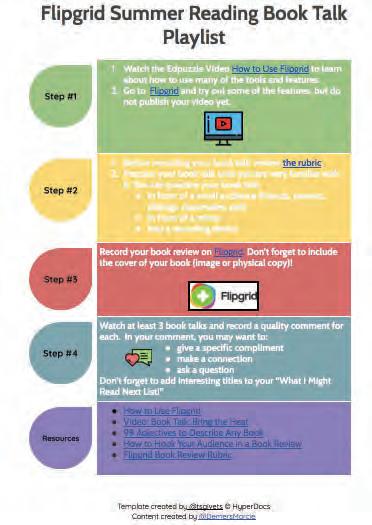
Above right: Flipgrid in use to assess students’ understanding of summer reading. At right, SeeSaw is used to assess progress in math.
